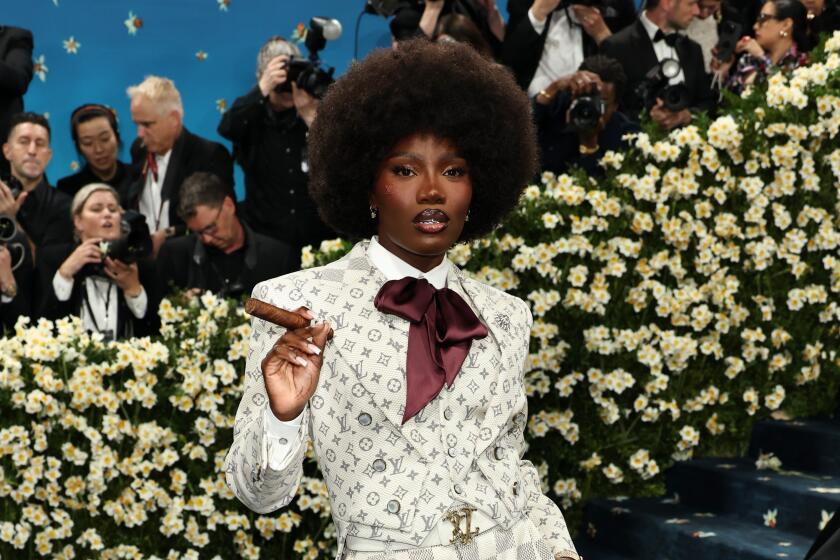This party mix can cost plenty
- Share via
To the untrained eye, Hollywood is alive with impetuous bursts of celebration, populated by the impossibly beautiful and the overpaid. Here, it seems, there are no rheumy-eyed barflies or bitter nobodies. Instead, everyone is famous and styled by professionals. And the decor -- which is always retro or camp or noir -- exudes just the right amount of exclusivity and sex appeal.
This image, perpetuated by so many glossy magazines and tabloid TV shows, seems a natural outgrowth of Los Angeles’ high celebrity concentration. Take a closer look, however, and you’ll see the machine behind the “magic.”
In L.A., it’s the event producers who bring this fantasy to life. They develop sophisticated concepts, scout locations, secure permits, hire DJs, performers, valets, choose decor, coordinate lighting and -- most important -- they create the List. Only a handful of people are trusted with the most high-profile events, full-scale productions that take months and small armies to plan. For this service, they’re typically paid a minimum of 20% of the party’s budget, which overall can hit $1 million.
“The job of the party producer is like the director on a movie,” says Brent Bolthouse of Bolt- house Productions, an A-list party designer who created No Doubt’s New Year’s Eve bash and birthday events for party demigods Tobey Maguire and Leonardo DiCaprio.
Event producers agree that a good party is one that’s nearly impossible to get into. It’s crucial, they say, to have the right mix of people. Too many beautiful women scare off the lesser mortals. Not enough, and guests start quoting the “Swingers” character Charles: “This place is dead anyway!”
Invitations to Vanity Fair’s Oscar night party, for example, are the most sought after primarily because it’s virtually the only place you’ll see Dr. Ruth Westheimer and Jake Gyllenhaal in the same room. Granted, even that party breaks up around 2 a.m.
Timing is also key. Every night in Hollywood there are half a dozen professionally orchestrated parties. If one event falls flat, the crowd moves on. That’s because sticking out a bad party can be poison to the guests’ reputations, particularly when image is a commodity. Parties aren’t just for fun, they’re an extension of the entertainment industry’s hype machine.
“Work and play are one here in Los Angeles,” says Jeffrey Best, whose Best Events produces parties for Miramax, Paramount Pictures and Sony’s PlayStation 2.
At the Oscar night after-party thrown in March by Endeavor agent Patrick Whitesell, the Firm agent Rick Yorn and DreamWorks executive Michael DeLuca, Bolthouse set some ground rules. No cameras. No entertainment press. And a balanced ratio of “young actor guys” to “cute actress girls.” Ultimately, he says, 600 people showed up and the party carried on until sunrise.
“It’s not who’s there,” says party producer Bryan Rabin of Rabin Rodgers Inc. “It’s who’s not there.”
In February, Rabin hosted a book party for novelist Helen Knode, whose husband is novelist James Ellroy. At this one, the “cute actress girl” was in the minority. Instead, the Pacific Dining Car, a decades-old restaurant near downtown Los Angeles, was packed with homicide detectives and private eyes, a sex columnist and actors Bruce Willis and David Duchovny. “Too much of any group is a bad thing,” says Rabin.
The one party that does not adhere to this approach is what Bolthouse termed the “step and repeat” event, so called because at the party entrance, the stars step up to a wall covered with sponsor logos, pose for cameras and then repeat the whole process along the red carpet. This kind of gathering is more marketing strategy than celebration. It often involves “celebrity wrangling” or luring the young and the restless stars with limo rides, extravagant gift bags and VIP rooms. In return, the celebrities graciously agree to be photographed at the party and -- just like that -- the sponsor earns a star endorsement.
Maxim magazine has mastered this style of party as branding tool. At its Super Bowl party, event producer Best created “Maximville” in San Diego, with a Dodge carwash, a Sony PlayStation 2 drive-in and a Coors Light “brewery.” With budgets “in the healthy six figures,” says publisher Jamie Hooper, the events are raucous and packed with women, media and corporate sponsors.
“Hugh Hefner has skipped out of a mansion party to go to our party, because he knows that this is the sort of place to be.”
More to Read
The biggest entertainment stories
Get our big stories about Hollywood, film, television, music, arts, culture and more right in your inbox as soon as they publish.
You may occasionally receive promotional content from the Los Angeles Times.










